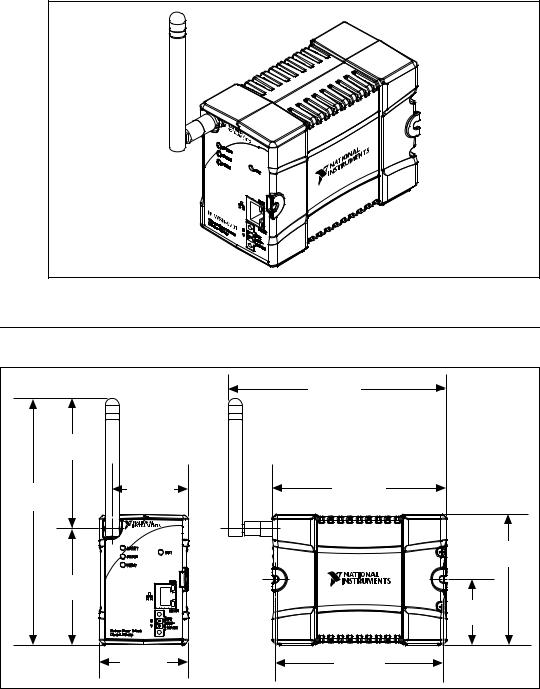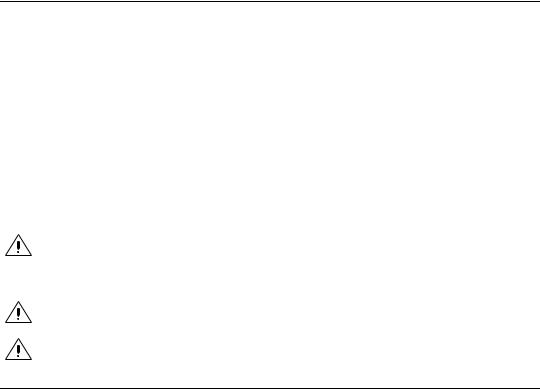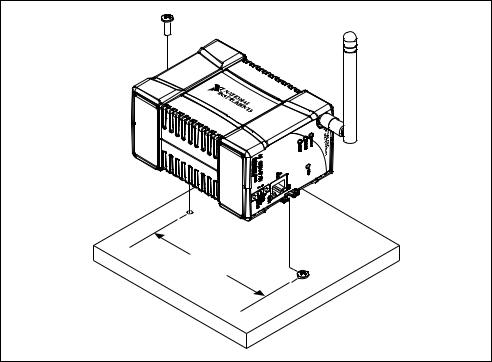National Instruments NI WSN-9791 User Manual

USER GUIDE AND SPECIFICATIONS
NI WSN-9791 Ethernet Gateway
This user guide describes how to use the NI Wireless Sensor Network WSN-9791 Ethernet gateway and lists specifications. The NI WSN-9791 provides an Ethernet data acquisition interface. The
NI WSN-9791 combines with NI WSN-32xx nodes to form a wireless sensor network. Figure 1 shows the components of the NI WSN system.
1
2
4 |
5 |
3 |
|
|
|
|
3 |
|
1 |
PC or NI Real-Time Hardware Running |
3 |
NI WSN-32xx Nodes |
|
Application Software |
4 |
Ethernet Cable/Connection |
2 |
NI WSN-9791 Ethernet Gateway |
5 |
9–30 VDC Power Supply Connection |
|
|
|
|
Figure 1. NI WSN System Components

Figure 2 shows a close up of the NI WSN-9791.
Figure 2. NI WSN-9791 Ethernet Gateway
Dimensions
Figure 3 shows the NI WSN-9791 device dimensions.
|
|
146.88 mm |
|
|
|
(5.783 in.) |
|
87.50 mm |
|
|
|
(3.445 in.) |
|
|
|
165.94 mm |
51.29 mm |
117.54 mm |
|
(2.019 in.) |
(4.628 in.) |
||
(6.533 in.) |
|||
|
|
||
|
|
88.33 mm |
|
|
|
(3.478 in.) |
|
3.088 in. |
|
|
|
(78.44 mm) |
|
|
|
|
|
44.32 mm |
|
|
NI WSN-9791 |
(1.745 in.) |
|
|
|
||
|
60.18 mm |
112.97 mm |
|
|
(2.369 in.) |
(4.448 in.) |
Figure 3. NI WSN-9791 Device Dimensions
NI WSN-9791 User Guide and Specifications |
2 |
ni.com |

Safety Guidelines
Operate the NI WSN-9791 only as described in this user guide.
Hot Surface This icon denotes that the component may be hot. Touching this component may result in bodily injury.
NI WSN Safety Information
The following section contains important safety information that you must follow when installing and using NI WSN products.
Caution Do not substitute parts or modify the NI WSN product. Use the product only with the devices, accessories, and cables specified in the installation instructions.
Caution Do not operate a NI WSN products in an explosive atmosphere or where there may be flammable gases or fumes. If you need to operate NI WSN products in such an environment, the NI WSN products must be in a suitably rated enclosure.
Caution If you need to clean a NI WSN product, use a dry towel. The product must be completely dry and free from contaminants before you return it to service.
Caution Operate the product only at or below Pollution Degree 2. Pollution is foreign matter in a solid, liquid, or gaseous state that can reduce dielectric strength or surface resistivity. The following is a description of pollution degrees:
•Pollution Degree 1 means no pollution or only dry, nonconductive pollution occurs. The pollution has no influence.
•Pollution Degree 2 means that only nonconductive pollution occurs in most cases. Occasionally, however, a temporary conductivity caused by condensation must be expected.
•Pollution Degree 3 means that conductive pollution occurs, or dry, nonconductive pollution occurs which becomes conductive due to condensation.
Caution You must insulate signal connections for the maximum voltage for which the NI WSN product is rated. Do not exceed the maximum ratings for the product. Do not install wiring while the product is live with electrical signals. Do not remove or add connector blocks when power is connected to the NI WSN system. Avoid contact between your body and the connector block signal wiring when hot-swapping devices.
Operate NI WSN products at or below the installation category1 marked on the hardware label. Measurement circuits are subjected to working voltages2 and transient stresses (overvoltage) from the circuit to which they are connected during measurement or test. Installation categories establish standard impulse withstand voltage levels that commonly occur in electrical distribution systems. The following is a description of installation categories:
•Installation Category I is for measurements performed on circuits not directly connected to the electrical distribution system referred to as MAINS3 voltage. This category is for measurements of voltages from specially protected secondary circuits. Such voltage measurements include signal
1Installation categories, also referred to as measurement categories, are defined in electrical safety standard IEC 61010-1.
2Working voltage is the highest rms value of an AC or DC voltage that can occur across any particular insulation.
3MAINS is defined as a hazardous live electrical supply system that powers equipment. Suitably rated measuring circuits may be connected to the MAINS for measuring purposes.
© National Instruments Corporation |
3 |
NI WSN-9791 User Guide and Specifications |

levels, special equipment, limited-energy parts of equipment, circuits powered by regulated low-voltage sources, and electronics.
•Installation Category II is for measurements performed on circuits directly connected to the electrical distribution system. This category refers to local-level electrical distribution, such as that provided by a standard wall outlet (for example, 115 V for U.S. or 230 V for Europe). Examples of Installation Category II are measurements performed on household appliances, portable tools, and similar products.
•Installation Category III is for measurements performed in the building installation at the distribution level. This category refers to measurements on hard-wired equipment such as equipment in fixed installations, distribution boards, and circuit breakers. Other examples are wiring, including cables, bus-bars, junction boxes, switches, socket-outlets in the fixed installation, and stationary motors with permanent connections to fixed installations.
•Installation Category IV is for measurements performed at the primary electrical supply installation (<1,000 V). Examples include electricity meters and measurements on primary overcurrent protection devices and on ripple control units.
Safety Guidelines for Hazardous Locations
The NI WSN-9791 is suitable for use in Class I, Division 2, Groups A, B, C, D, T4 hazardous locations; Class I, Zone 2, AEx nC IIC T4 and Ex nL IIC T4 hazardous locations; and nonhazardous locations only. Follow these guidelines if you are installing the NI WSN-9791 in a potentially explosive environment. Not following these guidelines may result in serious injury or death.
Caution Do not disconnect the power supply wires and connectors from the gateway unless power has been switched off.
Caution Do not install or remove the gateway unless power has been switched off.
Caution Substitution of components may impair suitability for Class I, Division 2.
Caution For Zone 2 applications, install the WSN system in an enclosure rated to at least IP 54 as defined by IEC 60529 and EN 60529.
Special Conditions for Hazardous Locations Use in Europe
The NI WSN-9791 has been evaluated as Ex nA nL IIC T4 equipment under DEMKO Certificate No. 07 ATEX 0626664X. Each gateway is marked II 3G and is suitable for use in Zone 2 hazardous locations, in ambient temperatures of –40 °C ≤ Ta ≤ 70 °C.
NI WSN-9791 User Guide and Specifications |
4 |
ni.com |

Electromagnetic Compatibility Guidelines
This product was tested and complies with the regulatory requirements and limits for electromagnetic compatibility (EMC) as stated in the product specifications. These requirements and limits are designed to provide reasonable protection against harmful interference when the product is operated in its intended operational electromagnetic environment.
This product is intended for use in industrial locations. There is no guarantee that harmful interference will not occur in a particular installation, when the product is connected to a test object, or if the product is used in residential areas. To minimize the potential for the product to cause interference to radio and television reception or to experience unacceptable performance degradation, install and use this product in strict accordance with the instructions in the product documentation.
Furthermore, any changes or modifications to the product not expressly approved by National Instruments could void your authority to operate it under your local regulatory rules.
The following statements contain important EMC information needed before installing and using this product:
Caution This product is intended for use in industrial locations. As a result, this product may cause interference if used in residential areas. Such use must be avoided unless the user takes special measures to reduce electromagnetic emissions to prevent interference to the reception of radio and television broadcasts.
Caution Changes or modifications not expressly approved by National Instruments could void the your authority to operate the hardware under the local regulatory rules.
Caution Operate this product only with shielded cables and accessories.
Related Documentation
Check ni.com/manuals for the most recent hardware documentation. For a complete list of documentation related to the NI WSN system, refer to ni.com/info and enter rdwsnrd.
In addition to this guide, the following documents may be useful when configuring your NI WSN system:
•NI Wireless Sensor Network Getting Started Guide
•NI WSN-32xx User Guide and Specifications
•Configuring WSN in MAX, available from Start»All Programs»National Instruments»NI-WSN
•The NI-WSN book on the Contents tab of the LabVIEW Help available by selecting Help»Search the LabVIEW Help in LabVIEW
•NI-WSN Readme, available on the software installation disc included with your device.
Training Courses
If you need more help getting started developing an application with NI products, NI offers training courses. To enroll in a course or obtain a detailed course outline, refer to ni.com/training.
Technical Support on the Web
For additional support, refer to ni.com/support or zone.ni.com.
© National Instruments Corporation |
5 |
NI WSN-9791 User Guide and Specifications |

Software Overview
Note Refer to the NI WSN Readme, available on the software installation disc included with your device, for NI software application version support.
The NI-WSN software includes NI Measurement and Automation Explorer (MAX) as well as server and driver software for easy integration into application software packages. These software components manage the low-level communications and hardware details, simplifying programmatic access to
I/O channels. The NI-WSN software is on the software installation disc included with your
NI WSN-9791 gateway device. The NI-WSN software is supported by Windows 7/Vista/XP and contains the following components:
•NI MAX
•NI-WSN software
You can download a current version of the NI-WSN software from ni.com/support. Using your web browser, go to ni.com/support and select Drivers and Updates»Distributed I/O»Wireless Sensor Networks, then select the latest version of NI-WSN software. If you are using other software, refer to the installation instructions that accompany your software.
What You Need to Get Started
To set up and use NI LabVIEW for WSN with the NI WSN-9791, you need the following:
•NI WSN-9791 Ethernet Gateway device(s), with 9–30 V power supply
•NI WSN-32xx node devices with a 9–30 V power supply or four 1.5 V AA alkaline for each node
•Mounting hardware (DIN rail, panel-mount, or rack mount accessory)
•Ethernet cable/connection
•Screwdrivers: a 1/8 in. flathead and a number 1 Phillips
•NI-WSN software version 1.1 or later
•Host PC running Windows 7/Vista/XP
•NI LabVIEW version 8.6.1 (32-bit) or later
•NI LabVIEW Real-Time Module (32-bit)
•Related hardware and software documentation
•Optional accessories
•DIN rail terminal blocks
•I/O cables and sensors
•Mounting accessory
NI WSN-9791 User Guide and Specifications |
6 |
ni.com |

Unpack the Devices and Install the Antenna
Remove the devices from the package and inspect the device. Contact NI if the device appears damaged. Do not install a damaged device.
Caution The device is static sensitive. Always properly ground yourself and the equipment when handling or connecting to the device.
To attach the antenna, align the antenna with the mount and screw it on as shown in Figure 4.
Caution The antenna must be attached to the NI WSN device in order for the NI WSN device to function correctly.
Figure 4. Attach Antenna to Device
Mounting the NI WSN-9791 Device
You can mount the NI WSN-9791 device on a panel or on a 35 mm DIN rail. For kit accessory ordering information, refer to the accessory section of the NI WSN product page at ni.com.
Caution Your installation must meet the following requirements:
•Allows 25.4 mm (1 in.) of clearance above and below the NI WSN-9791 device for air circulation.
•Allows 50.8 mm (2 in.) of clearance in front of modules for common connector cabling, such as the 2-position detachable screw terminal connector.
© National Instruments Corporation |
7 |
NI WSN-9791 User Guide and Specifications |

Note Figure 5 is an actual size template. You can print it out and use it to determine screw hole placement for panel mounting.
3.18 mm |
(0.125in.) |
101.60 mm |
|
|
(4.000 in.) |
|
|
||
|
|
|
||
|
|
9791 |
114.30 mm |
(4.500 in.) |
|
|
NI WSN- |
|
|
|
55.88 mm |
45.72 mm |
|
|
|
(2.200 in.) |
(1.800 in.) |
|
|
mm18.3 ).in125.(0 |
|
|
|
|
Figure 5. NI WSN-9791 Panel Mount Dimensions Template
NI WSN-9791 User Guide and Specifications |
8 |
ni.com |

Using the Integrated Panel Mount Feature
The NI WSN-9791 integrated panel mount feature accepts number 8 or M4 pan head screws to secure the device onto a flat surface. To install the NI WSN-9791 on a flat surface, complete the following steps:
1.Prepare two holes in your panel 4.448 in. (112.97 mm) on center to accept the number 8 or M4 pan head screws or bolts.
2.Install the front screw first in the mounting panel leaving .08 in. space under the head of the screw.
3.Slide the NI WSN-9791 front mount under this screw.
4.Fasten the rear screw into place through the rear enclosure mount of the NI WSN-9791.
4. |
|
|
|
(114. 500 |
in |
||
3 |
|
||
0 |
mm) |
. |
|
|
|
||
Figure 6. Using the Integrated Mount Feature
© National Instruments Corporation |
9 |
NI WSN-9791 User Guide and Specifications |
